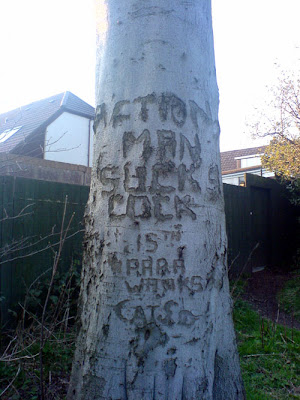A thing of beauty is a joy forever
 Sometimes, as you amble through life while happily minding your own business, you're hit by something that stops you dead in your tracks and leaves you winded, like a punch in the solar plexus.
Sometimes, as you amble through life while happily minding your own business, you're hit by something that stops you dead in your tracks and leaves you winded, like a punch in the solar plexus.Filthy Pen correspondent Stuart Farquhar knows exactly how such a wallop feels. One afternoon, after viewing a house in Polmont, just east of the Scottish town of Falkirk, he wandered away from the property to see what the surrounding area was like. Spotting what appeared to be a message written on a tree, he moved a little closer in order to read it. What he saw stunned him. He could hardly believe his eyes.
What an astonishing sight. And what a fantastically multi-layered piece of work. As Stuart himself writes in the covering note submitted with his image: “The craftsmanship is to be commended, and the job must've taken at least 20 minutes to complete. It is a stunning amalgam of nature and sweary word. God knows when it was hewn - perhaps it was 15 years ago and it has grown with the tree? ... The truth is perhaps as unknowable as the motivation behind the message.”
With the aid of that trusty researchers' tool Google (other search engines are available) it can be ascertained that the 15th (Scottish) Battalion Parachute Regiment, to give it its full name, was founded in 1947 as a Territorial Army unit by “the legendary Alastair Pearson CB, DSO and three bars, MC, TD”. It was based in Glasgow, with units and companies in Aberdeen, Dundee, Perth and Edinburgh.
In its time, 15 Para saw action and adventure. It was also touched by tragedy. On the night of 11 September 1974, while on a NATO exercise in Germany, five of its members drowned when freak wind patterns during a parachute jump caused them to drift off course and land in the Kiel Canal. As well as pathos, there were stirring feats of derring-do; just a few months before the Kiel catastrophe, for example, one lucky parachutist had been saved from certain death when he was grabbed by another in mid-air after his chute failed to open. Heroic Boy's Own stuff indeed.
After a long and distinguished service record, 15 Para ceased to exist in 1993. It was disbanded as part of the reorganisation of the British armed forces following the end of the Cold War, a victim of the peace dividend. Based on this information, it would appear that Stuart's casual guess as to the age of the carvings is perhaps more accurate than he might have imagined.
Enough of the history though. Let's propose a bold theory here. The Territorial Army, despite their excellent work and unstinting professionalism, are often derided by outsiders as being little more than a grown-up version of children playing at being real soldiers. The first piece of graffiti, which claims that Action Man practices fellatio, is therefore unlikely to refer to the popular boys' toy. Instead, it's probably a disparaging comment about a particular member of the Territorial Army who lived in the locale. Sticking with this theory, we can deduce that the second piece of work is likely to refer to that same individual member of 15 Para.
We can only imagine what such a distinguished figure as Alastair Pearson, his highly-polished medals glinting in the sunlight, would have made of one of his creation's soldiers being branded - to put it in office-safe firewall-friendly terms - a sausage-noshing feline fiddler.
What level of truth lies behind these tree-carved statements? Was the target an innocent victim of gossip, innuendo and hearsay, spread by neighbours he thought were his friends? Are the accusations based on fact? Was Polmont once rocked by the behaviour of a part-time troop living in its midst? Was a family pet really given a special tickle by a man in uniform? We can only wonder.
Leaving the moral issues behind, in aesthetic terms the level of dedication and effort that went into creating this work is nothing short of outstanding. Over the years, the tree has grown and the carving has swollen, but the inscriptions remain legible. As if aware of the lasting legacy of their work, this was no swift scrape with a penknife. This was carried out with surgical precision. As Stuart rightly pointed out, it must have taken ages to complete.
Yet despite running the risk of being apprehended mid-chisel, the perpetrator kept their head. Not only was the quality of workmanship maintained, it actually improved as the job progressed - note that final pointed A in CATS, compared to the earlier flat-topped lettering. That's the mark of a true craftsman, driven on by the urge to surpass a previous effort and expand their skills base. Marvellous. Hats off to whoever it was in the dim and distant past who carried this out. And the same goes for Stuart, for taking the time to send the picture in. Respeck.
The Filthy Pen's mission to collect and present some of the finest examples of graffiti found littering our landscape has been suffering from the digital equivalent of a gammy leg lately. It's purposeful cyberstride has deteriorated into a virtual limping gait, and this is its first posting in a shameful 10 weeks. The arrival of the inspirational image supplied by Stuart has injected some much-needed vim and vigour back into the project though.
With an ever-increasing collection of images stockpiled in TFP's files - a great many of them submitted by eager correspondents and virtually all worthy of exposure - here's to a glorious second wind. May it blow long and gustily.

